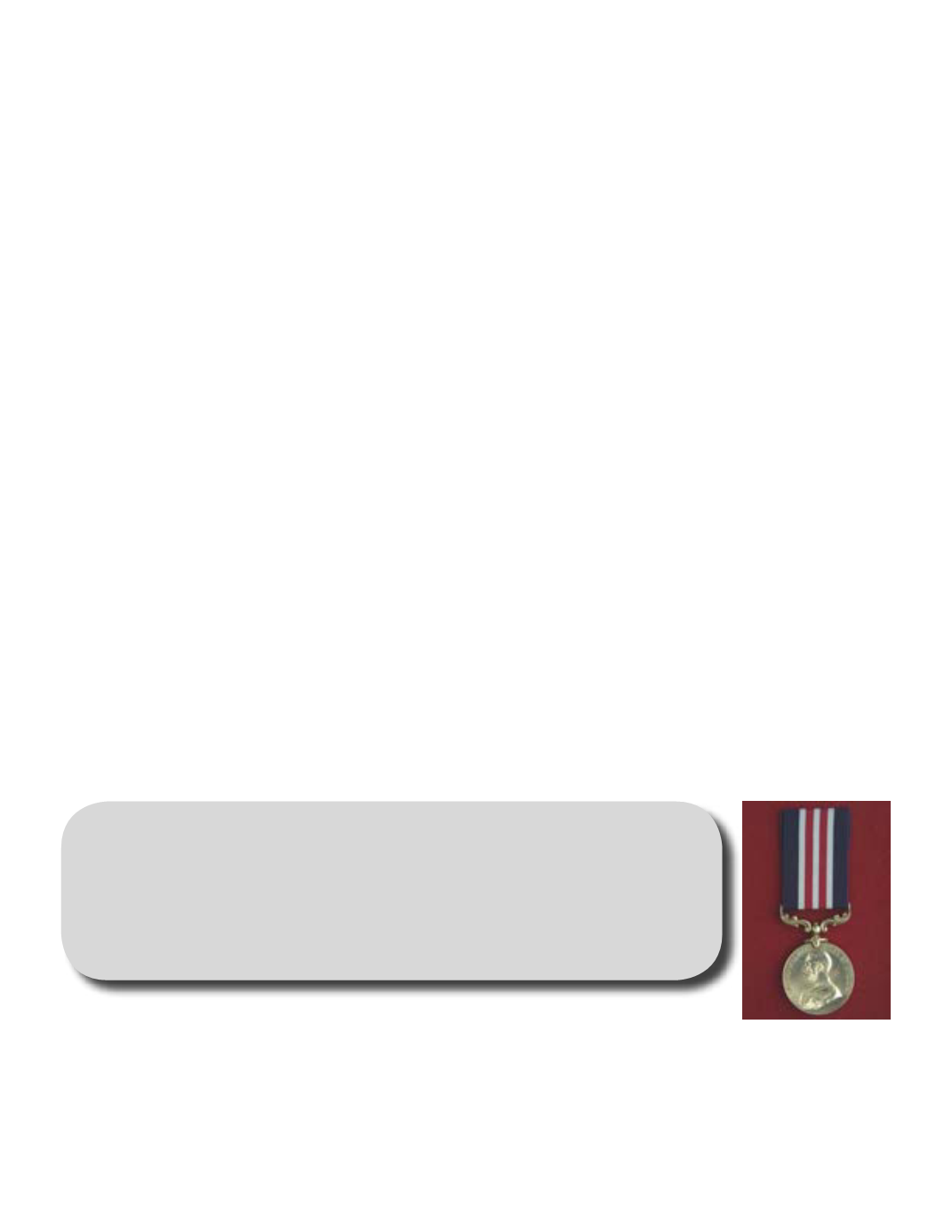
WorldWar I
FallenSoldiers - RockwoodCenotaph
Page 4
JOHNS. COKER, MM, MiD
18027Sergeant
JohnS. Coker was born on2March 1885 to John
andHannah (neeBolton) Coker of RR #3Eramosa.
Hewas the youngest of their four children (William
b.1874, JamesThomas b.1876 andMary b.?).
His grandparents immigrated toEramosaTownship fromScotland before the birth of his father in
1860. Johnwas raised inEramosaTownship and after his education, became a carpenter and
hada reputation as an accomplishedwoodsman. Hewas amember of the local militia – the 30th
CanadianRegiment (WellingtonRifles) for 5 years. Around 1912, Johnand a friend travelledwest to
thePeaceRiver District ofAlberta.
While living inAlberta, John joined the 101st Regiment (EdmontonFusiliers) on 18August 1914.
Tendays later, theRegiment arrived inValcartier, Quebec for short and strenuous basic training.
During this time, his attestation papers show that he volunteered for overseas service on 22
September. At QuebecCity on3October, the regiment boarded theS.S. Zeeland for the crossing to
England. After arriving on the18th inDevonport (Plymouth) England, theyweremoved toSalisbury
Plain formore intensive training duringwhich they lived in tents through a cold andmiserable
winter. The regiment’s namewas changed to the 9thBattalion, CanadianExpeditionary Force (9th
BnCEF) but was designateda reserve unit to train andprovide replacement soldiers for those lost
inbattle at the front. At this time, PrivateCoker was transferred to the 3rd (Toronto) Battalion and
inFebruary 1915, he attended theDivisional TrainingSchool. Hewas subsequently promoted
toCorporal and then on 11 June, hewas promoted toSergeant. He earned a reputationas an
Born:
2March 1885 inEramosaTownship, Ontario
PreviousOccupation:
Carpenter
Enlisted:
18August 1914 inEdmonton,Alberta
Died:
3May 1917at the age of 32
Buried:
AubignyCommunal Cemetery, at Pas de
Calais, France
The
30thRegimentWellingtonRifles
evolved from the 1st BattalionWellingtonRifles. They
wereorganized in 1857 from the local militiawithinWellingtonCounty andwereheadquartered in
Guelph. In 1866, because of the fear of theFenianRaids (1866-1871) theywere re-organized as
an infantry unit (30thRegimentWellingtonRifles) and a separate artillery unit (GuelphGarrison
Battery, laterWellingtonFieldBattery). In the late 19th and early 20th centuries, manymen joined
their local militia. Inaddition to the camaraderieof weekly training, rank achievedwithin themilitia
tended tohave a corresponding level of prestigewithin the local community.
The 30thWellingtonRifleswere nevermobilizedas a unit forWWI. Instead, they performed
recruitingduties locally. After training inCanada, their recruitswere assigned to operational
regiments for overseas service. Seventy years after theywere separated, these twoWellington
County regimentsweremerged back into a larger artillery battery that has continued through to
today as the11thField, Royal Regiment of CanadianArtillery.
FallenSoldiers - RockwoodCenotaph
5
accomplishedmarksman. By July 1915, the 3rdBn hadmoved to theWalloon (French speaking)
Region inBelgium. Theywere located at Piggeries near the town of Ploegsteert and approximately
2 kms north of the border withFrance. PloegsteertWoodwas the site of fierceWWI fighting. The
Ploegsteert Memorial to theMissing commemoratesmore than 11,000missing and assumed killed
inactionCommonwealth soldierswho died in thearea during that time.
By early 1917, Sergeant Coker’s regiment was nearArras, in northernFrance. On 9April, hewas
mentioned in the dispatches (MiD) of FieldMarshall Sir DouglasHaig for his gallant actions during
the opening day of theBattle of VimyRidge. TheCanadianCorps succeeded in capturingVimy
Ridgeon 12April. Less than twoweeks later andwithin less than 10 kms of Vimy, his bravery in
actionwas again recognized andhewas recommended for theMilitaryMedal. Unfortunately, on
3May 1917, at the age of 32 years and 4months, Sergeant JohnCoker died of wounds that he
received in action duringwhat was known as theFresnoyEngagement.After his death on 18 July
1917, hewas awarded theMilitaryMedal (MM) for gallantry for his earlier actions on 23/26April.
The citation reads:
“ThisN.C.O. is recommended for conspicuousgallantry atARLEUXon the afternoonof
April 24, 1917, whenhisplatoonwas subjected to extremelyheavy enemybombardment.
Sergeant Coker byhisgood judgment (sic) andpersonal supervisionplacedhisplatoon
so that it sufferedonly four casualties.”
“Againon 23/24April 1917, thisN.C.O. showedgreat dash anddetermination in leading
aBattlepatrol of twelvemen into the enemy line, obtainingmuch valuable information
as regards to the stateof hisdefences and againon thenight of 25/26April hewasof
invaluable assistance tohisCompanyCommander in sitinganddigging anew lineof
trench, 500 yards in advanceof hisown line. Thiswasunder heavy artillery andmachine
gunfire.”
Hewas buried in theAubignyCommunal Cemetery, at Pas deCalais, France and his name is
alsomemorialized in theBooks of Remembrance, in thePeaceTower of theCanadianParliament
Buildings, Ottawa. HisMilitaryMedal, 1914-1915Star, VictoryMedal andBritishWarMedal were
sent to hismother at RR #1Eramosa.
TheMilitaryMedal (MM) is awarded toWarrant Officers, non-commissioned
officers andmen for individual or associated acts of bravery on the
recommendation of aComman er-in-Chief in the field. The regimenta o
quivalen number, rank, initials, sur ame nd unit of the recipient appear in
plainblock capitals around the edge of themedal.
TheMilitaryMedal


